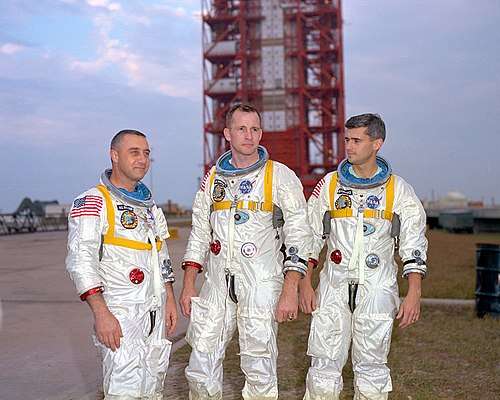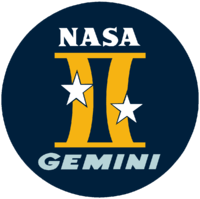Ed White (astronaut)
Edward Higgins "Ed" White II (November 14, 1930 – January 27, 1967) (Lt Col, USAF) was an American aeronautical engineer, U.S. Air Force officer, test pilot, and NASA astronaut.
Edward H. White II | |
|---|---|
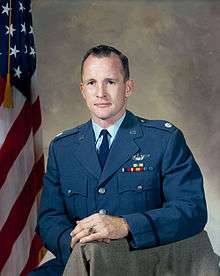 White in 1966 | |
| Born | Edward Higgins White II November 14, 1930 San Antonio, Texas, U.S. |
| Died | January 27, 1967 (aged 36) Cape Kennedy, Florida, U.S. |
| Resting place | West Point Cemetery |
| Nationality | American |
| Alma mater |
|
| Occupation | Fighter pilot, test pilot |
| Awards | |
| Space career | |
| NASA Astronaut | |
| Rank | |
Time in space | 4d 01h 56m |
| Selection | 1962 NASA Group 2 |
Total EVAs | 1 |
Total EVA time | 36 minutes |
| Missions | Gemini 4, Apollo 1 |
Mission insignia | |
After graduating from West Point in 1952 with a Bachelor of Science degree, White was sent to flight training, and assigned to the 22nd Fighter Day Squadron at Bitburg Air Base, West Germany. There, he flew in F-86 Sabre and F-100 Super Sabre squadrons. In 1958, he enrolled in the University of Michigan to study aeronautical engineering. White then received test pilot training at Edwards Air Force Base, California, before being assigned as a test pilot for the Aeronautical Systems Division at Wright-Patterson Air Force Base, Ohio.
White was selected as one of the second group of astronauts. He was assigned as pilot of Gemini 4 alongside command pilot James McDivitt. On June 3, 1965, White became the first American to walk in space. He was then assigned as senior pilot of the first crewed Apollo mission, Apollo 1. White died on January 27, 1967, alongside astronauts Virgil "Gus" Grissom and Roger B. Chaffee in a fire during pre-launch testing for Apollo 1 at Cape Canaveral, Florida. He was awarded the NASA Distinguished Service Medal for his flight in Gemini 4 and was then awarded the Congressional Space Medal of Honor posthumously.
Early life
White was born on November 14, 1930, in San Antonio, Texas, to parents Edward Higgins White Sr. (1901–1978), a West Point graduate and major general in the U.S. Air Force,[1] and Mary Rosina White (née Haller; 1900–1983).[2][3] He also has a younger brother, James Blair White (1942–1969)[4], and had an older sister, Dorotha J. (née White) Roberts (1928–1952).[5] His interest in aviation was sparked after his father allowed him to fly in a T-6 trainer at the age of twelve.[6] He became a member of the Boy Scouts of America,[7] where he earned the rank of Second Class Scout.[8]
Due of the nature of his father's job, White's family moved often to different military bases across the country throughout his childhood. The White family moved from San Antonio, Texas to Dayton, Ohio, where he attended Oakwood Junior High School.[9] They then moved to Washington, D.C., where White attended Western High School. After graduating in 1948, he was accepted to the United States Military Academy at West Point, where in 1952 he graduated with a Bachelor of Science degree.
While at West Point, White competed for a spot on the 1952 U.S. Olympic team in the 400 meter hurdles race, but missed making the team by 4/10 second.[10] White was also a half-back on the West Point soccer team.[11] His hobbies included squash, handball, swimming, golf, and photography.
Military service
White joined the Air Force, and received his initial pilot training at Bartow Air Force Base, Florida, and his jet training at James Connally Air Force Base, Texas. After receiving his pilot wings in 1953, White was commissioned as a Second Lieutenant, and was sent to Luke Air Force Base, Arizona for Fighter Gunnery School.[12] He was then assigned to the 22nd Fighter Day Squadron at Bitburg Air Base, West Germany, where he spent three and a half years flying in F-86 Sabre and F-100 Super Sabre squadrons in the defense of NATO. Among his colleagues were Buzz Aldrin, who was a year ahead of him at West Point.[13][14][15]
In 1957, White read an article about the future of astronauts, and decided to become an astronaut. He believed that getting an advanced degree would improve his chances of becoming selected.[11] In 1958, White enrolled in the University of Michigan under Air Force sponsorship to study aeronautical engineering, where he received his Master of Science degree in 1959.[16] After it became clear that being a test pilot would improve his chances of becoming selected as an astronaut, he attended the U.S. Air Force Test Pilot School at Edwards Air Force Base, California in July 1959. He earned his credentials as a test pilot and was assigned to the Aeronautical Systems Division at Wright-Patterson Air Force Base, Ohio. There, he did flight tests for weapons development, and helped make recommendations for aircraft design. As weightlessness and extended flight training captain, he also piloted the planes used to train astronauts in weightlessness, such as the C-131, the C-135, and the F-100F. Some of his passengers included John Glenn, the first American to orbit the Earth, and Ham, the first hominid in space.[11] During his career, White would log more than 3,000 flight hours with the Air Force, including about 2,200 hours in jets, and would ultimately attain the rank of Lieutenant Colonel.[14]
NASA career
Gemini program
Gemini 4
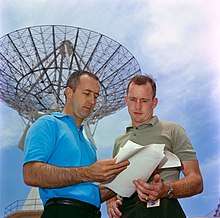
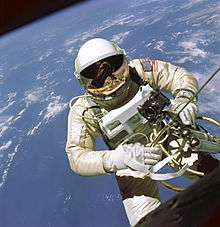
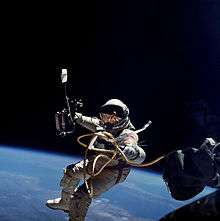
White was one of nine men chosen as part of the second group of astronauts in 1962.[19][20] Within an already elite group, White was considered to be skilled by the management of NASA. He was selected to be Pilot of Gemini 4, serving alongside Command Pilot James McDivitt.[21]
On June 3, 1965, the Gemini 4 crew was launched into space to begin its four-day mission. After separation from the Titan II upper stage, McDivitt attempted to rendezvous with the booster. However, this was unsuccessful since the astronauts were not adequately trained to rendezvous in orbit. The objective had to be abandoned since the allocated propellant had been used up, and the maneuvers had pushed the spacecraft's orbit too far away from Earth.[22][23]
After the failed rendezvous attempt, White appeared tired and hot, so the EVA was postponed from the second revolution to the third revolution. At 19:46 UTC, White became the first American to make a walk in space.[24] During his spacewalk, White used an oxygen propelled gun called the Hand-Held Maneuvering Unit to propel himself. White found the experience so exhilarating that he was reluctant to terminate the EVA at the allotted time, and had to be ordered back into the spacecraft.[25] While he was outside, a spare thermal glove floated away through the open hatch of the spacecraft, becoming an early piece of space debris in low Earth orbit, until it burned up upon re-entry into the Earth's atmosphere.[25][26] There was a mechanical problem with the hatch mechanism, which made it difficult to open and to relatch. Luckily, McDivitt was able to get the door locked by using his glove to push on the gears that controlled the mechanism. This added to the time constraint of the spacewalk and could have threatened the lives of both men if McDivitt had been unable to get the hatch latched, as they could not re-enter the atmosphere with an unsealed hatch.[24][27]
I'm coming back in... and it's the saddest moment of my life.
— Astronaut Edward H. White while reentering the spacecraft after his EVA, [28]
The mission also included 11 different scientific experiments, including the use of a sextant for celestial navigation.[29]
White's next assignment after Gemini 4 was as the backup for Gemini 7 Command Pilot Frank Borman.[30][31] He was also named the astronaut specialist for the flight control systems of the Apollo Command/Service Module. By the usual procedure of crew rotation in the Gemini program, White would have been in line for a second flight as the command pilot of Gemini 10 in July 1966, which would have made him the first of his group to fly twice.[31]
Apollo program
Apollo 1
In March 1966 White was selected as senior pilot (second seat) for the first crewed Apollo flight, designated AS-204. His fellow astronauts would be Command Pilot Virgil "Gus" Grissom, who had flown in space on the Liberty Bell 7 Mercury mission and as Commander of the Molly Brown Gemini mission, and Pilot Roger Chaffee, who had yet to fly into space.[14] The mission, which the men named Apollo 1 in June, was originally planned for late 1966 to rendezvous with the last Gemini mission, but the impracticality of making the Gemini capsule and systems compatible with Apollo and delays in the spacecraft development pushed the launch into 1967.[32][33]
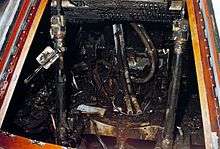
The launch of Apollo 1 was planned for February 21, 1967. The crew entered the spacecraft at 1:00 pm on January 27, mounted atop its Saturn IB booster on Launch Pad 34 at Cape Kennedy, for a "plugs-out" test of the spacecraft.[11] The test was to demonstrate all of the space vehicle systems and procedures, which included an abbreviated countdown and flight simulation.[34] It was not classified as hazardous since the rocket would not be fueled during the test. The test's progress was delayed by problems with a cabin odor and poor communications between the ground stations and the crew. At 6:31 pm, a fire broke out in the pure oxygen-filled cabin, killing all three men.[35]
Emergency roles had called for White to actuate the inner hatch release handle; then, Grissom would assist him in the removal of the cover, while Chaffee would maintain communications. White had apparently tried to do his part: his body was found in his center seat, with his arms reaching over his head toward the hatch.[34][36] Removing the cover to open the hatch was impossible because the plug door design required venting normally slightly greater-than-atmospheric pressure and pulling the cover into the cabin.[37] Grissom was unable to reach the cabin vent control to his left, where the fire's source was located. The intense heat raised the cabin pressure even more, to 29 pounds per square inch (200 kPa), at which point the cabin walls ruptured.[38] The astronauts were killed by asphyxiation, smoke inhalation, and thermal burns.[35][39]
Aftermath
The fire's ignition source was determined to be a spark that jumped from a wire on the far left of the spacecraft, under Grissom's seat,[39][40][41] but their deaths were attributed to a wide range of lethal hazards in the early Apollo Command Module design, workmanship and conditions of the test, including the highly pressurized 100% oxygen pre-launch atmosphere, many wiring and plumbing flaws, flammable materials used in the cockpit and the astronauts' flight suits, and a hatch which could not be quickly opened in an emergency.[37][42] After the incident, these problems were fixed, and the Apollo program carried on successfully to reach its objective of landing men on the Moon.[35]
White was buried with full military honors at West Point Cemetery while Grissom and Chaffee are both buried in Arlington National Cemetery.[43]
In 1997, White was posthumously awarded the Congressional Space Medal of Honor. White was inducted into the U.S. Astronaut Hall of Fame in 1993[44][45] and the National Aviation Hall of Fame on July 18, 2009.[46][47]
White's wife Patricia received $100,000 from the life insurance portion of the contract the astronauts signed to give two publishing firms exclusive rights to the stories and photographs of the astronauts and their families. She also received $16,250 annually for the life of the contract.[48] Patricia later remarried and continued to reside in Houston. On September 7, 1983, she took her own life after surgery earlier in the year to remove a tumor.[49][50]
Organizations
White was a member of the Society of Experimental Test Pilots; associate member of Institute of Aerospace Sciences; Tau Delta Phi (Engineering Honorary); and Sigma Delta Psi (Athletic Honorary).[14]
Awards and honors
- Senior Astronaut Wings[14]
- Air Force Commendation Medal[44]
- Golden Plate Award of the American Academy of Achievement, 1965[51]
- Medalha Bandeirantes va Cosmonautica[14]
- Firefly Club Award[14]
- Ten Outstanding Young Men of the Nation, 1965[52]
- Five Outstanding Young Texans, 1965[53]
- National Aviation Club's Achievement Award, 1966[54]
White and McDivitt were presented honorary doctorate degrees in astronautical science by the University of Michigan after their Gemini 4 flight.[55] Later that week they traveled to the White House where President Johnson presented them the NASA Exceptional Service Medal.[56] The duo were also awarded the Arnold Air Society's John F. Kennedy Trophy.[57] White received the 1965 General Thomas D. White National Defense Award for his spacewalk. It is a trophy given by the National Geographic Society to outstanding air force personnel.[58] He was inducted into the Aerospace Primus Club (the "most exclusive club on Earth") for his EVA.[59] He was awarded the AIAA Haley Astronautics Award for 1967.[60] The Apollo 1 crew was awarded the NASA Distinguished Service Medal posthumously in a 1969 presentation of the Presidential Medal of Freedom to the Apollo 11 crew.[61]
White, along with nine other Gemini astronauts, was inducted into the International Space Hall of Fame in 1982.[62][63] President Clinton presented the White and Chaffee families with the Congressional Space Medal of Honor in 1997 (Grissom's family received the medal in 1978).[64]
Memorials
Schools
Many schools have been named in honor of Lt Colonel White:
- Edward White Elementary Career Academy in Chicago[65]
- Edward H. White Middle School in White's hometown of San Antonio, Texas[66]
- Edward H. White II Elementary School in El Lago, Texas[67][68]
- Edward White Elementary School in Eldridge, Iowa[69]
- Ed White Memorial High School in League City, Texas[70]
- Edward H. White High School in Jacksonville, Florida[71]
- Edward H. White Elementary School in Houston, Texas.[72]
- Ed White Middle School in Huntsville, Alabama[73] Huntsville is home to NASA's Marshall Space Flight Center and has strong community ties to the space program. At the same time, the Huntsville City Schools named Roger B. Chaffee Elementary School and Virgil I. Grissom High School for White's fallen Apollo 1 crewmates.[74]
- Edward H. White Memorial Youth Center, Seabrook, Texas[75]
Other sites


- Edward White Hospital in St. Petersburg, Florida (closed in 2014).[76]
- Edward H. White II Park in Fullerton, California. Fullerton has also named parks in honor of Chaffee and Grissom.[77]
- Island White, an artificial island in Long Beach Harbor off Southern California.[78][79]
- Edward H. White Hall was a dormitory at Sheppard Air Force Base in Wichita Falls, Texas.[80] White Hall housed the 365th Training Squadron until 2010. The 365th trains aircraft avionics technicians.
- McDivitt-White Plaza is located outside West Hall at the University of Michigan. West Hall formerly housed the College of Engineering and counts James McDivitt and Ed White among its alumni (McDivitt earned his B.S. and White earned his M.S. at the University of Michigan).[81]
- The dismantled Launch Pad 34 at Cape Canaveral bears two memorial plaques. One reads, "They gave their lives in service to their country in the ongoing exploration of humankind's final frontier. Remember them not for how they died but for those ideals for which they lived." and the other "In memory of those who made the ultimate sacrifice so others could reach for the stars. Ad astra per aspera, (a rough road leads to the stars). God speed to the crew of Apollo 1."[13]
- Edward H. White II American Legion Post 521; Pasadena, Texas.[82]
- Edward White Park in Garland, Texas.[83]
In space
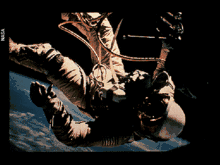
- The star Iota Ursae Majoris was nicknamed "Dnoces" ("Second", as in "Edward Higgins White the Second", spelled backwards).[84]
- White Hill, 11.2 km (7.0 mi) northwest of Columbia Memorial Station on Mars, is a part of the Apollo 1 Hills.[85]
- A photograph of White performing his Gemini 4 space walk is included as one of several images on the Voyager Golden Record.[86]
Philatelic

- Eight months after his death, in September 1967, a postage stamp was issued by the United States Post Office, commemorating White's spacewalk.[87] It was the first time in USPO history that the design was actually spread over two stamps (one which featured White, the other his Gemini capsule, the two connected by a tether), which was considered befitting the "twins" aspect of the Gemini mission.[74]
Omega Speedmaster "Ed White"
The Omega Speedmaster wristwatch reference 105.003 has come to be known as the "Ed White" as this reference was worn by White during his spacewalk. The Speedmaster remains the only watch qualified by NASA for EVA use.[88]
In media
White was played by Steven Ruge in the 1995 film Apollo 13,[89] by Chris Isaak in the 1998 HBO miniseries From the Earth to the Moon,[90] and by Matt Lanter in the 2015 ABC TV series The Astronaut Wives Club.[91] In 2018, he was portrayed by Jason Clarke in First Man.[92]
See also
- Alexei Leonov – first man to conduct a spacewalk
- Fallen Astronaut
- List of spaceflight-related accidents and incidents
- Voskhod 2 – Soviet space mission which included the first spacewalk
- Accomplishments in Space Commemorative stamp
References
- "MAJOR GENERAL EDWARD H. WHITE > U.S. Air Force > Biography Display". www.af.mil. Retrieved 2019-06-26.
- Angell, Cory (June 20, 2018). "Vietnam Fighter Pilot Finally Comes Home". Los Angeles Air Force Base. Retrieved January 19, 2020.
- Mary Rosina Haller White
- James Blair White
- Dorotha J. White Roberts
- White, Mary. "Detailed Biographies of Apollo I Crew – Ed White". Nasa History. Archived from the original on September 15, 2019. Retrieved September 15, 2019.
- "Astronauts and the BSA". Fact sheet. Boy Scouts of America. Archived from the original on April 14, 2009. Retrieved March 20, 2006.
- "Edward Higgins White at scouting.org". Archived from the original on March 3, 2016.
- "White II, Edward Higgens". The National Aviation Hall of Fame. Archived from the original on October 13, 2017. Retrieved January 20, 2020.
- Hymans, Richard (2008). "The History of United States Olympic Trials – Track and Field" (PDF). USA Track and Field. Archived from the original (PDF) on May 17, 2019. Retrieved May 17, 2019.
1. Moore 52.0, 2. Yoder 52.6, 3. Blackman 52.7, 4. Edward White (USAF) 53.1
- White, Mary C. "Detailed Biographies of Apollo I Crew – Ed White". NASA. Retrieved January 25, 2018.
- Burgess, Colin (2013). Moon Bound: Choosing and Preparing NASA's Lunar Astronauts. Springer Science & Business Media. p. 156. ISBN 9781461438557.
- "The Official Site of Edward White II". Cmgww.com. Archived from the original on 2013-12-03. Retrieved 2013-11-28.
- "Astronaut Bio: Edward H. White II". Biographical Data. NASA. December 1997. Archived from the original on October 17, 2018. Retrieved 2013-11-28.
- "Astronaut Bio: Buzz Aldrin". January 1996. Archived from the original on April 2, 2009. Retrieved January 19, 2020.
- Sandberg, Ariel (February 8, 2017). "Reflecting on Apollo 1 disaster, U-M alum astronaut Ed White". The Michigan News Engineer Center. Archived from the original on May 16, 2019. Retrieved May 16, 2019.
- Baer, Bonnie; White III, Ed (October 20, 2018). "When our dad, astronaut Ed White, died, he showed that the future belongs to the brave". Dallas News. Retrieved May 12, 2019.
- Burgess, Colin and Doolan, Kate, with Vis, Bert (2003). Fallen Astronauts: Heroes Who Died Reaching for the Moon, Lincoln and London: University of Nebraska Press. ISBN 0-8032-6212-4
- Evans, Ben (September 15, 2012). ""The Best All-Around Group": NASA's Astronauts of '62". AmericaSpace. Archived from the original on May 16, 2019. Retrieved May 16, 2019.
- "Here are the Next Nine Astronauts Who Will Join in U.S. Race to the Moon". The Tampa Tribune. Tampa, Florida. UPI. September 18, 1962. p. 4 – via Newspapers.com.
- "Edward H. White II". Encyclopedia Britannica. January 25, 2019. Archived from the original on May 15, 2019. Retrieved May 14, 2019.
- Wade, Mark. "Gemini 4". Encyclopedia Astronautica. Archived from the original on July 16, 2019. Retrieved January 18, 2020.
- "Gemini/Program Mission Report" (PDF). NASA Technical Reports Server. June 1965. Archived (PDF) from the original on July 1, 2019. Retrieved January 18, 2020.
- "NASA – NSSDCA – Spacecraft – Details". nssdc.gsfc.nasa.gov. Retrieved 2019-05-15.
- Barbree, Jay (2007). "Live from Cape Canaveral". New York: HarperCollins. pp. 111, 112. ISBN 978-0-06-123392-0.
- Moskowitz, Clara (February 13, 2019). "Lost in Space: 8 Weird Pieces of Space Junk". Wired. Archived from the original on December 25, 2018. Retrieved May 16, 2019.
- McDivitt, James (June 29, 1999). "Oral History Transcript" (PDF). National Aeronautics and Space Administration. Interviewed by Doug Ward. Archived from the original (PDF) on June 22, 2011. Retrieved January 19, 2020.
- Composite Air-to-ground and Onboard Voice Tape Transcription of the GT-4 Mission (U) (PDF), NASA, 31 August 1965, p. 54
- Granath, Bob (June 1, 2015). "Gemini IV: Learning to Walk in Space". NASA. Archived from the original on July 16, 2019. Retrieved January 18, 2020.
- "Gemini 7". Astronautix. Archived from the original on May 17, 2019. Retrieved May 16, 2019.
The backup crew for the flight, which would last up to 14 days, would be Edward H. White II and Michael Collins.
- Shayler, David (2001). Gemini Steps to the Moon. London: Springer. p. 109. ISBN 978-1-85233-405-5.
- Portree, David (August 25, 2012). "Before the Fire: Saturn-Apollo Applications (1966)". Wired. Archived from the original on May 17, 2019. Retrieved May 16, 2019.
- Gebhardt, Chris (January 26, 2017). "50 years on, reminders of Apollo 1 beckon a safer future". NASA Spaceflight.com. Archived from the original on May 19, 2019. Retrieved May 19, 2019.
- "Apollo 1". National Aeronautics and Space Administration. Archived from the original on May 17, 2019. Retrieved May 17, 2019.
- Logsdon, John (2018). The Penguin Book of Outer Space Exploration. New York: Penguin Books. pp. 207–214. ISBN 978-0-14-312995-0.
- Thompson; et al. (April 5, 1967). "Review of Apollo 204 Review Board" (PDF). NASA. Archived (PDF) from the original on July 14, 2019. Retrieved January 22, 2020.
- Long, Tony (January 27, 2011). "Jan. 27, 1967: 3 Astronauts Die in Launchpad Fire". Wired. Archived from the original on May 17, 2019. Retrieved May 17, 2019.
- Larimer, Sarah (January 26, 2017). "'We have a fire in the cockpit!' The Apollo 1 disaster 50 years later". The New York Times. Retrieved May 14, 2019.
- "Apollo 1 (AS-204)". Smithsonian National Air and Space Museum. Archived from the original on April 11, 2019. Retrieved May 14, 2019.
- Howell, Elizabeth (November 16, 2017). "Apollo 1: The Fatal Fire". Space.com. Archived from the original on April 17, 2019. Retrieved May 13, 2019.
- Kluger, Jeffrey, Apollo 8: The Thrilling Story of the First Mission to the Moon (Henry Holt & Co., 2017), p. 94. "At precisely 6:31 p.m., a spark jumped from a wire on the far left of the spacecraft, beneath Gus Grissom's seat. The wire ran beneath a little storage compartment with a metal door that had been opened and closed many times without anybody noticing that each time the door moved, it abraded a little more of the wire's insulation, finally leaving the wire free to spark at will. When the wire sparked during the plugs-out test, it ignited a small fire that stayed small for only a second or two. Accelerated by the pure oxygen, the flames climbed along the left-hand wall of the spacecraft, feeding on fabric and netting used for storage. That was the worst possible place for a fire to erupt, since it prevented Grissom from reaching a latch that would have opened a valve and vented the high-pressure atmosphere, thus slowing the flames."
- "Findings, Determinations And Recommendations". Report of Apollo 204 Review Board. NASA. April 5, 1967.
No single ignition source of the fire was conclusively identified.
- "West Point Cemetery" (PDF). United States Military Academy West Point. Archived from the original (PDF) on February 25, 2014. Retrieved January 25, 2018.
- "Edward H. White II | Astronaut Scholarship Foundation".
- Clark, Amy (March 14, 1993). "Activities Honor Gemini Astronauts". Florida Today. Cocoa, Florida. p. 41 – via Newspapers.com.
- Kaplan, Ron (December 17, 2008). "National Aviation Hall of Fame reveals names of "Class of 2009" inductees". National Aviation Hall of Fame web site. National Aviation Hall of Fame. Retrieved 2009-02-16.
- Hannah, James (July 19, 2009). "Ed White, Jimmy Stewart inducted in Aviation Hall". Washington Post.
- "Widows Will Get $100,000 From Life Insurance". Bridgeport Sunday Post. January 29, 1967. p. 3. Archived from the original on August 12, 2017. Retrieved July 5, 2017 – via Newspapers.com.
- UPI (1983-09-08). "Pat White's obituary in New York Times". Nytimes.com. Retrieved 2013-11-28.
- "NASA Wives and Families". Pbs.org. Retrieved 2013-11-28.
- "Golden Plate Awardees of the American Academy of Achievement". www.achievement.org. American Academy of Achievement.
- "Two Spacemen, LBJ Press Aide in 1965's 'Elite'". The Lawton Constitution And Morning Press. Lawton, Oklahoma. January 9, 1966 – via Newspapers.com.
- "House Speaker Among Five Outstanding Young Texans". Brownwood Bulletin. Brownwood, Texas. Associated Press. January 9, 1966. p. 1 – via Newspapers.com.
- "Henderson Trophy Recipient Chronology". National Aeronautic Association. Retrieved May 30, 2019.
- "Four Days to Earn Doctorates". The News-Palladium. Benton Harbor, Michigan. Associated Press. June 16, 1965. p. 13 – via Newspapers.com.
- "Johnson Honors Space Twins in Washington". Longview News-Journal. UPI. June 17, 1965. p. 1 – via Newspapers.com.
- "Gemini 4 Astronauts get JFK Trophy". Republican and Herald. Pottsville, Pennsylvania. April 9, 1966. p. 3 – via Newspapers.com.
- "The Gen. Thomas D. White USAF Space Trophy" (PDF). USAF. May 1997. p. 156. Cite magazine requires
|magazine=(help) - "Ed White II: Air Force Aerospace Primus Club Plaque from His Personal Collection". Heritage Auctions. Retrieved May 29, 2019.
- "Haley Astronautics Award to White". Beatrice Daily Sun. Beatrice, Nebraska. Associated Press. February 8, 1967. p. 19 – via Newspapers.com.
- Smith, Merriman (August 14, 1969). "Astronauts Awed by the Acclaim". The Honolulu Advertiser. Honolulu, Hawaii. UPI. p. 1 – via Newspapers.com.
- "The First American to walk in space". New Mexico Museum of Space History. Retrieved January 24, 2018.
- Shay, Erin (October 3, 1982). "Astronauts Laud Gemini as Precursor to Shuttle". Albuquerque Journal. Albuquerque, New Mexico. p. 3 – via Newspapers.com.
- "Congressional Space Medal of Honor". C-SPAN. December 17, 1997. Archived from the original on October 16, 2012. Retrieved June 16, 2016.
- Herman, Edith (September 7, 1971). "Full Staffs Await City's School Bells". Chicago Tribune. Chicago, Illinois. p. Section 2 Page 9 – via Newspapers.com.
- "Edward H. White Middle School". San Antonio, Texas: North East Independent School District. Retrieved July 20, 2009.
- "Ed White Elementary School". Clear Creek ISD. Archived from the original on August 11, 2009. Retrieved July 20, 2009.
- "Ed H. White Elementary". Clear Creek Independent School District. Archived from the original on April 1, 2014. Retrieved July 13, 2013.
- "North Scott Community School District". Archived from the original on September 27, 2011. Retrieved August 8, 2011.
- "Bay Area Charter Schools". Archived from the original on July 12, 2009. Retrieved July 20, 2009.
- Allen, Rick (April 7, 1972). "Band from School Named for Son Surprises White". The Tampa Tribune. Tampa, Florida. p. 4 – via Newspapers.com.
- "History of Ed White". Ed White Elementary. Retrieved January 24, 2018.
- "Ed White Middle School". Huntsville (Ala.) City Schools official site. Archived from the original on 2007-08-18. Retrieved 2007-06-12.
- Jaques, Bob (June 6, 2002). "First spacewalk by American astronaut 37 years ago" (PDF). Marshall Star. NASA Marshall Space Flight Center. p. 5. Archived from the original (PDF) on July 11, 2009. Retrieved June 22, 2008.
- "Ed White Memorial Youth Center". Ed White Memorial Youth Center. Archived from the original on February 12, 2008. Retrieved July 11, 2008.
- "Hospital Closure". HCA West Florida. Retrieved January 24, 2018.
- "City of Fullerton – List of Parks". Ci.fullerton.ca.us. Retrieved 2013-11-28.
- Michael Robert Patterson. "Fallen Astronaut". Arlingtoncemetery.net. Retrieved 2013-11-28.
- "pdf of City of Long Beach Economic Zones". Archived from the original on July 13, 2010. Retrieved 2013-11-28.
- "A Brief History of the 82d Training Wing and Sheppard AFB" (PDF). Retrieved January 24, 2018.
- Vielmetti, Edward (May 25, 2010). "Our neighborhoods: South University as seen from McDivitt-White Plaza". The Ann Arbor News. Retrieved January 24, 2018.
- "Post History". American Legion Post 521. Archived from the original on August 31, 2016. Retrieved January 24, 2018.
- "Google Maps". Google Maps. Retrieved 2019-07-22.
- "Apollo 15 Lunar Surface Journal". NASA. Retrieved January 23, 2018.
- "Martian Landmarks Dedicated to Apollo 1 Crew". NASA. January 27, 2004. Retrieved January 23, 2018.
- "Here's What Humanity Wanted Aliens to Know About Us in 1977". Time. January 22, 2016. Retrieved January 23, 2018.
- "Gemini Space Walk". Sky Image Lab. Retrieved July 20, 2009.
- "An Omega Speedmaster Reference 105.003 "Ed White" Circa 1965". Hondinkee. June 27, 2011. Archived from the original on September 14, 2019. Retrieved September 14, 2019.
- "Apollo 13 (1995)". IMDb.
- James, Caryn (April 3, 1998). "Television Review; Boyish Eyes on the Moon". The New York Times. Retrieved August 5, 2018.
- Nededog, Jethro (November 25, 2014). "'90210's' Matt Lanter Signs On for ABC's 'Astronaut Wives Club' (Exclusive)". The Wrap. Retrieved May 30, 2019.
- Richford, Rhonda (September 1, 2018). "'First Man' Star Jason Clarke Dismisses Flag Criticism: "It's Nonsense"". The Hollywood Reporter. Retrieved May 30, 2019.
External links
| Wikimedia Commons has media related to Edward Higgins White. |
| Wikiquote has quotations related to: Edward Higgins White |
